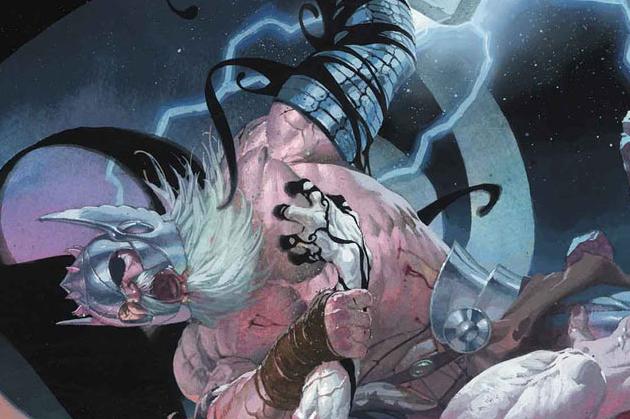Thor: God of Thunder #10
SPOILERS! HAVE AT THEE!
If you haven't been reading Thor: God of Thunder, you've got a thunder-god-shaped hole in your pull list.
Jason Aaron has a history of being hit-or-miss with me. I enjoyed a fair portion of his Wolverine work, disliked a fair portion of his Wolverine work, despised Wolverine and the X-Men... (Really. It's just awful. Don't waste your money.) But I can safely say that although a mite heavy-handed in its delivery of the high themes contained within it, Jason Aaron's Thor is unequivocally blowing most of Marvel's other books out of the water. The significant difference, however, is that while Marvel's best titles right now (think Hawkguy, FF, etc.) have a lighter, more adventurous, and almost comedic tone, Thor: God of Thunder is as heavy, brooding and murky as they come.
The arc began ten issues ago with splendid new elements, discarding the more “comic booky” aspects of Thor and focusing on a grave, ancient mythology that expands far past earth into the cosmos. This arc has brought together the Thors of three different points of time—a wild young Thor living among the Vikings in Norway circa the 800's; an ancient, regal King Thor defending the ruins of Asgard thousands of years in the future; and Thor the Avenger, the familiar, super-heroic hammer-slinger with whom we're all familiar.
But unfamiliar to us, at the beginning, was Gorr the God Butcher, a spacefaring serial killer of gods. Hell-bent on destroying the legacy of religion, Gorr cannot rest until he enslaves, tortures and murders every god. From every mythology. From every planet... in every galaxy. And every era in time.
Heft up Mjolnir and cue the godly beatdown. It's bloody. It's brutal. It's ugly. It's magnificent.
If it sounds ambitious, that's because it is. The conflict between anti-theism and religion is pretty heady material to tackle in a comic book, especially directly and with no veil of symbolism. And the sheer mind-boggling physical scope of the story is no small task for an artist, not to mention that any writer in his right mind despises time-travel because it is the arch-nemesis of linear storytelling and simple plots. But Jason Aaron and the laudable Esad Ribic have maneuvered spectacularly despite all obstacles, and delivered a story wholly worth reading.
Issue #10 finds our heroes separated from their hammers and each other, weakened, and unable to disarm or dismantle Gorr's magnum opus: the Godbomb. The Godbomb is exactly what it sounds like: a contraption which, when detonated, will rock the entire time-stream and end all gods from the beginning to the end of time. It is triggered by blood—the blood of Thor. Gorr, the slayer of gods, has apparently triumphed when his only son, seeing clearly the devastation and hatred his father has spread, betrays his father into the hands of the gods.
I'll be honest. I know I always spoil the whole thing, but I want to leave the ending open this time. I will tell you this, however: what ensues throughout the rest of the book—to the very last page—is what we all read Thor comics to see: battle. And in that context, three Thors are better than one. The action is elegantly, masterfully crafted by Esad Ribic, whose deep and subtle colors are coupled with a soaring, Wagnerian sense of drama that makes his work never less than utterly enthralling and never short on moments of frisson. Even the the dirtiest and bloodiest of acts looks stunning and poetic through Ribic's art. King Thor nailed to a speeding comet and sent spiraling into the gaping abyss of deep space? Check. Ever wanted to see Thor the Avenger smash his enemies with not one, but TWO Mjolnirs? Because that totally happens. Just. I'm serious. Read the issue. The culminating moment of all of these, though, has to be when a battered and bloodied Young Thor, about to be bled out on the “altar” that is the core of Gorr's Godbomb, musters all his gall and spirit to viciously bite out Gorr's eye.
You heard me. Young Thor tears out Gorr's eyeball with his teeth. Ruminate on that for a second before reading on.
The conflict between people who love gods and people who hate gods is a bitter and endless struggle in the real world. To see a fictional story with such exceptional art and skillful writing that reflects the issues as more than simply the people who espouse them is refreshing. It shows me that mature narrative and well-developed themes are not dead in the sequential-art medium, nor are complex but powerful characters still capable of clearly and viscerally portraying doubt, piety, hatred, loyalty, and selfishness.
This story is for everyone. It's about how to react to doubt, tragedy, unanswered prayers, and a universe gone horribly wrong: fight evil and never let darkness win. No matter who you are. Jason Aaron has given us a morality tale about the difference between being RIGHT and being GOOD. And that is something everyone needs to learn.
I am eagerly awaiting the final moments of this story. If you're wondering, it's definitely worth the money.







Comments